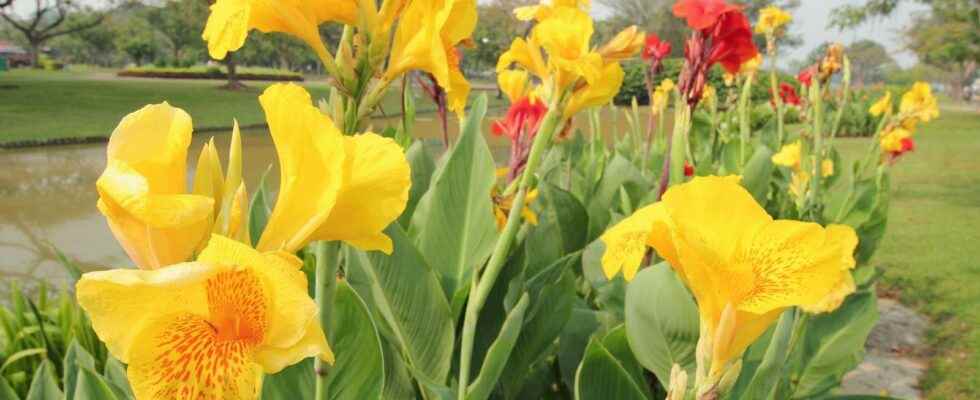With its decorative purple, green or variegated foliage, very close to the banana tree and its very colorful trumpet-shaped flowers, the canna illuminates gardens from July to October. The colors bright, plain or spotted, as well as the imposing silhouette of the cannas make these summer flowering perennial bulbs the stars of the flower beds exotic. Succumb to their exceptional long flowering and their imposing silhouette of impressive foliage.
Appellations
This rhizomatous perennial plant, also called the balisier, is part of the Cannaceae family (Cannaceae). There are dwarf cannas that do not exceed 80 centimeters in height to be installed in the middle of a bed and high cannas that can exceed two meters, to be planted in the background of the bed.
Botanical description of canna
It is a bulb developing stems over 1.50 meters high with large leaves and clusters of very colorful flowers. These panicles, in large numbers, bloom from July to October, depending on the variety. For the colors, there is something for everyone:
- ‘Angélique’, ‘Semaphore’ and ‘Durban’ for the orange flowers;
- ‘Brilliant’, ‘Firebird’, ‘Red Wine’ and indica for red blooms;
- ‘Pink President’ for inflorescences pink in color;
- ‘Confetti’, ‘Picasso’ or ‘Cleopatra’ for spotted flowers, very extravagant.
And for a touch of originality in your flower beds or pots, cultivate the variety ‘Stuttgart’ or ‘Durban’ with its magnificent variegated foliage, ‘Angelique’ for its purple-purplish foliage or ‘Red Wine’ for its large leaves tinged with red.
Origins of canna
Cannas grow in the forests and wetlands of Central America and tropical Asia.
Cultural requirements of canna
After May 15th, plant the cannas on a location with a light lively but avoid it Sun direct in the middle of the day and protect them from the wind. They appreciate a Earth rich and good drained with some sand or gravel. Add a scoop of compost when planting. Place each rhizome 10 centimeters deep and if you are planting several, space them at least 40 centimeters apart.
Given their rapid growth, leave room for maximum development. From spring tofall, bring water every week. Cut back faded flowers regularly to stimulate flowering. Watch out for slugs, fond of foliage. At the end of the season, harvest the seeds from the fruits that replaced the flowers.
The canna is chilly, so tear off rhizomes before winter, as soon as the foliage wilts, and store them in a crate filled with moist peat or sand. Cultivated in a pot, take it away from the cold in a greenhouse or in a shelter outside gel. In a warm area, leave them in the ground with mulch on top.
Use of canna
In the garden, bring color to a bed of perennials by mixing dwarf and tall cannas. Play with colors by associating them with dahlias. Dare the graphic foliage of ‘Durban’ cannas with foliage of cordylines, coleus or pennisetums. In one patio or a yard, on a balcony or a Terrace, grow cannas in pots or containers.
You will also be interested
Interested in what you just read?
.
fs12
